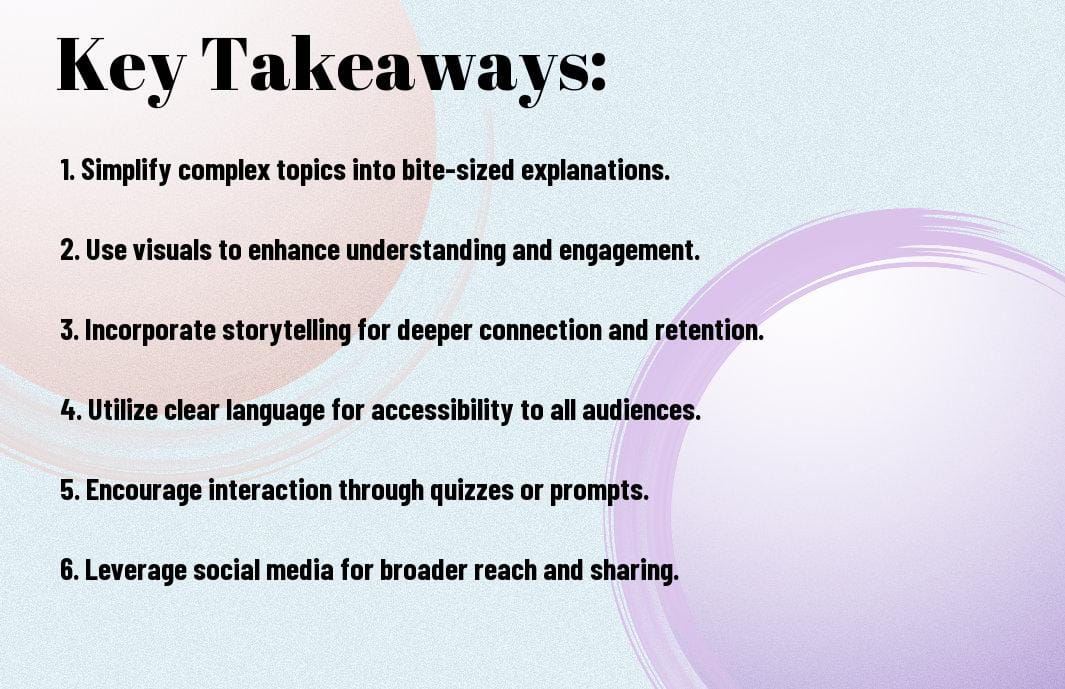Animated videos offer a dynamic way to simplify complex financial concepts, making them more accessible for you and your audience. With engaging visuals and concise storytelling, you can turn intimidating subjects into relatable knowledge that empowers your viewers. By utilizing animations, you not only enhance understanding but also maintain interest, ensuring your message resonates. To get started on this journey, explore resources on How to Create a Finance Animation Explainer Video and see how you can effectively communicate through animation.

Key Takeaways:
- Engagement: Animated videos capture attention, making complex financial concepts more appealing and memorable for viewers.
- Simplicity: Breaking down concepts into bite-sized segments helps viewers grasp information without feeling overwhelmed.
- Visual Representation: Utilizing visuals aids in illustrating abstract financial ideas, enhancing understanding and retention of the material.

Understanding Financial Concepts
While navigating the world of finance can often feel overwhelming, breaking down key concepts into digestible, animated videos can significantly enhance your understanding. These visual aids allow you to grasp complex ideas more easily by transforming abstract financial terminology into engaging narratives and relatable scenarios. By viewing animated content, you can connect the dots between theory and real-world applications, empowering you to make informed decisions about your finances.
Importance of Financial Literacy
Along your journey to becoming financially savvy, financial literacy plays a fundamental role in shaping your decision-making skills. It equips you with the knowledge to understand imperative concepts like budgeting, investing, and credit management, which can ultimately lead to better financial outcomes. When you are financially literate, you can avoid common pitfalls and make choices that enhance your financial well-being for the long term.
Common Financial Terms Explained
Below are some imperative financial terms that often baffle many aspiring financial enthusiasts. By familiarizing yourself with definitions and practical examples of terms like interest rates, assets, and liabilities, you can start to build a strong foundation that will support your financial journey. Animated videos can transform these often intimidating terms into visual stories, helping you see how they can impact your everyday life and long-term financial goals.
Importance lies in demystifying financial jargon so that you can engage confidently with your finances. It is imperative to not only learn what these terms mean but also to recognize their implications on your financial health. By understanding how investment works or what it means to take on debt, you can better navigate your choices and pave the way for achieving your personal financial goals. Armed with this knowledge, you are less likely to fall prey to misinformation and can take charge of your financial future.
The Power of Visual Learning
Some of the most effective ways to grasp complex financial ideas is through visual learning. By leveraging animated videos, you can present key concepts in a way that is not only engaging but also easier for your audience to understand. You can explore some of the most effective visual aids by checking out the Top 10 Animated Finance Explainer Videos. These videos can transform dry financial data into vibrant narratives, capturing attention and promoting better comprehension.
Cognitive Benefits of Animation
One of the standout advantages of using animation in financial education is its ability to simplify and condense information. Animated visuals can break down complex ideas into bite-sized, digestible pieces, making it easier for you to grasp the content. This mechanism can significantly facilitate your ability to connect different concepts together. When the intricate relationships between financial principles are illustrated through animations, you’re more likely to engage with the material on a deeper level.
How Animation Enhances Retention
Beside simplifying concepts, animation provides a dynamic and interactive learning experience that promotes higher retention rates. When you consume information through animation, you are more likely to engage both your auditory and visual senses, reinforcing the material in your memory. The combination of compelling visuals and sound can create a multisensory experience, making it easier for you to recall information when you need it.
A study found that learners who engaged with animated content retained up to 50% more information over traditional methods. This retention advantage is particularly significant in finance, where understanding fundamentals is necessary for making informed decisions. The visual storytelling approach taken by animated videos keeps your attention focused and enhances your ability to recall critical financial concepts long after you’ve consumed the content.
Creating Engaging Animated Videos
To effectively convey complex financial concepts, your animated videos must be both informative and captivating. This involves not only simplifying the information but also presenting it in a visually appealing way that keeps your audience’s attention. By utilizing color theory, motion design, and storytelling techniques, you can create videos that not only educate but also entertain. Incorporate characters and narratives that reflect real-life financial scenarios, making the content relatable and easier for viewers to grasp.
Key Elements of Effective Animation
Engaging animations rely on various key components that enhance viewer understanding and retention. First, consider the pacing of your video; the flow of information should be steady, allowing viewers to absorb what they learn without feeling rushed. Secondly, the use of visuals, such as graphs and charts, should not only reinforce your message but also be simplistic enough to avoid overwhelming the audience. Furthermore, appropriate voiceovers and sound effects can significantly enhance the overall experience, making your financial concepts more memorable.
Tools and Software for Animation
Across the spectrum of animation tools available today, you have a plethora of options to create your financial videos. From simple online platforms like Animaker and Powtoon to more professional software such as Adobe After Effects and Blender, each tool offers unique features that cater to different skill levels and requirements. The choice of software will ultimately depend on your specific needs and your familiarity with animation techniques.
Considering your desired outcomes, it’s important to select tools that align with your skill set and the complexity of the content you aim to produce. For instance, if you’re new to animation and need an accessible starting point, online tools offer user-friendly interfaces and templates to help you get started without a steep learning curve. On the other hand, for those comfortable with advanced techniques, software like Adobe After Effects provides in-depth capabilities for creating highly customized and professional-grade animations. The right choice can significantly enhance your ability to effectively communicate your financial concepts, ensuring your audience engages with your content.
Steps to Break Down Complex Topics
Your first step in breaking down complex financial topics is identifying the core concepts that form the foundation of the subject. This means stripping away extraneous details and focusing on the key ideas that you want your audience to understand. Between complicated terminologies and jargon, it’s easy to lose sight of what truly matters. By pinpointing these vital components, you can set the stage for creating clear and engaging animated videos that simplify the subject matter effectively.
Identify Core Concepts
Between different financial topics, there are certain principles or ideas that remain central. It’s important to identify these core concepts so that you can effectively convey them in your animations. Start by asking questions: What is the primary message you want to deliver? What will help your audience grasp the overall idea quickly? Once you have a firm grip on these core concepts, you can build your animated content around them, ensuring clarity and focus.
Simplify Language and Terminology
Identify terms and phrases that might be complex for your target audience. The key to creating accessible content lies in using language that is straightforward and relatable. This avoids overwhelming your viewers with unnecessary complexity. Your aim should be to take technical lingo and translate it into simple, digestible language. This is particularly vital in the finance domain where misunderstandings can lead to costly mistakes.
But the challenge is ensuring that the simplified language still accurately conveys the underlying concepts. This requires a balance between accessibility and precision. A solid approach may involve using analogies or examples from everyday life to illustrate difficult ideas, thereby making them more relatable. For instance, you can explain interest rates by comparing them to a rental fee on money, which may resonate better with an audience unfamiliar with financial terminology. By adopting this strategy, you enhance the learning experience and help your audience grasp concepts from a new perspective.

Case Studies: Successful Animated Videos
Many successful companies have harnessed the power of animated videos to demystify complex financial concepts and engage their audiences effectively. The impact of these videos often translates into higher viewer retention and increased consumer understanding. Below are some noteworthy case studies that highlight effective use of animation in the finance sector:
- Investment Firm XYZ: Increased viewer engagement by 75% after implementing animated explainer videos.
- Banking Institution ABC: Achieved a 50% increase in customer inquiries following the release of a simple animated short on savings accounts.
- FinTech Startup LMN: Saw conversion rates rise by 35% after a series of animated videos clarified their service offerings.
- Insurance Company DEF: Reported a 40% reduction in customer service calls after launching animated FAQs that explained their policies.
For more insights into how animated videos can elevate financial communication, check out Explainer Videos For Finance.
Examples from the Finance Industry
Among the various sectors, the finance industry tends to benefit significantly from animated videos that simplify sophisticated topics. For instance, a popular bank utilized an animated video to illustrate the process of applying for a mortgage, resulting in a remarkable 40% increase in completed applications. In another case, an investment company released a series of short animations explaining stock trading strategies, leading to a 60% rise in educational content engagement on their website.
Analyzing Viewer Engagement
Viewer behavior plays a vital role in assessing the effectiveness of animated financial videos. You should look at key performance indicators, such as watch time, click-through rates, and audience retention percentages. For instance, a finance explainer video that maintains an average of 80% viewer retention often correlates with high viewer interest and engagement with the subject matter. The ability to capture and retain your audience’s attention is crucial in making complex concepts more digestible.
Industry analysis shows that content with high viewer engagement not only enhances understanding but also fosters a stronger emotional connection with your audience. By tailoring your animated videos to address viewer pain points and expectations, you enable effective communication that can lead to not just improved comprehension but also customer loyalty. Videos that include relatable visuals combined with straightforward narratives can yield impressive results, such as a 25% increase in downloads for financial apps that offer a clear and concise explanatory video.
Incorporating Feedback for Improvement
Once again, one of the most powerful tools you have at your disposal when creating animated videos for financial concepts is the ability to incorporate viewer feedback. This process not only enhances the quality of your content but also ensures that you are meeting the needs of your audience. By actively seeking out and analyzing viewer insights, you can refine your approach and make your videos even more effective in simplifying complex financial ideas. Engaging with your viewers helps you understand their unique perspectives, allowing you to tailor your content to better address their questions and concerns.
Gathering Viewer Insights
Above all, gathering insights from your viewers can provide you with powerful information about what aspects of your videos resonate the most. You can use various methods such as surveys, social media polls, or direct comments to glean feedback on your content. Look for trends in the responses that highlight both the strengths and weaknesses of your videos. For example, if multiple viewers mention that a certain segment was difficult to understand, this signals a need for further simplification or elaboration.
Iterating on Content for Better Clarity
For each round of feedback you receive, take the time to iterate on your content for better clarity. This may involve breaking down complex topics into bite-sized pieces or using more relatable examples that your audience can connect with. Consistently updating your videos based on viewer feedback shows that you value their input and are committed to providing high-quality educational content. Don’t hesitate to rework animations, graphics, or narration styles to enhance viewer comprehension.
With each iteration, you will find it easier to convey financial concepts in a way that resonates with your audience. Consider implementing clear graphics, concise scripts, and relatable metaphors to make your videos more engaging. This iterative process not only enriches your content but also builds trust with your audience, as they see your commitment to their learning experience. Ultimately, this will create a more impactful educational journey that keeps viewers coming back for more.

Conclusion
Conclusively, utilizing animated videos to break down key financial concepts can significantly enhance your understanding and retention of important information. By engaging with visual narratives, you create a more immersive experience that allows complex ideas to become more digestible. This approach not only aids in grasping fundamental principles but also fosters a deeper appreciation for the structures that govern financial decision-making. Incorporating animated content into your learning strategy is a smart way to simplify the intricacies of finance.
Additionally, as you implement animated videos into your study routine, you will find that this method encourages active participation. Interactive elements often present in these videos can prompt you to think critically and apply what you’ve learned. Ultimately, by embracing this dynamic educational tool, you are equipping yourself with the knowledge needed to navigate the financial landscape with confidence and clarity.
FAQ
Q: What are the benefits of using animated videos to explain financial concepts?
A: Animated videos can simplify complex financial concepts through visual storytelling and engaging graphics. They make learning more enjoyable and can enhance information retention by pairing visuals with audio explanations. This approach caters to various learning styles and helps ensure that the material resonates with a broader audience.
Q: How do I choose the right financial concepts to animate?
A: Start by identifying the concepts that your audience struggles with most. Consider creating content on topics such as budgeting, investing, or understanding credit, as these are common areas of confusion. Additionally, pay attention to current trends in finance or the most frequently asked questions in the financial community to guide your selections.
Q: What tools or software can I use to create animated financial videos?
A: There are several user-friendly tools available for creating animated videos, such as Vyond, Animaker, and Powtoon. These platforms offer pre-made templates, animations, and customizable features that help facilitate the video creation process. Depending on your skill level, you can also explore more advanced software like Adobe After Effects for more sophisticated animations.
Q: How can I effectively script my animated video to ensure clarity and engagement?
A: To create an effective script, start with a clear outline of the main points you want to cover. Use simple language and explain financial jargon in layman’s terms. Aim for a conversational tone, which can make the content more relatable. Additionally, incorporate questions or scenarios to interact with your audience and maintain their interest.
Q: What are some best practices for promoting animated financial videos?
A: Promote your videos through various channels, including social media platforms, email newsletters, and your website. Engaging with online communities focused on finance or educational content can also help increase visibility. Consider collaborating with influencers or financial experts to share your videos, and utilize SEO strategies to optimize video titles and descriptions to boost searchability.



